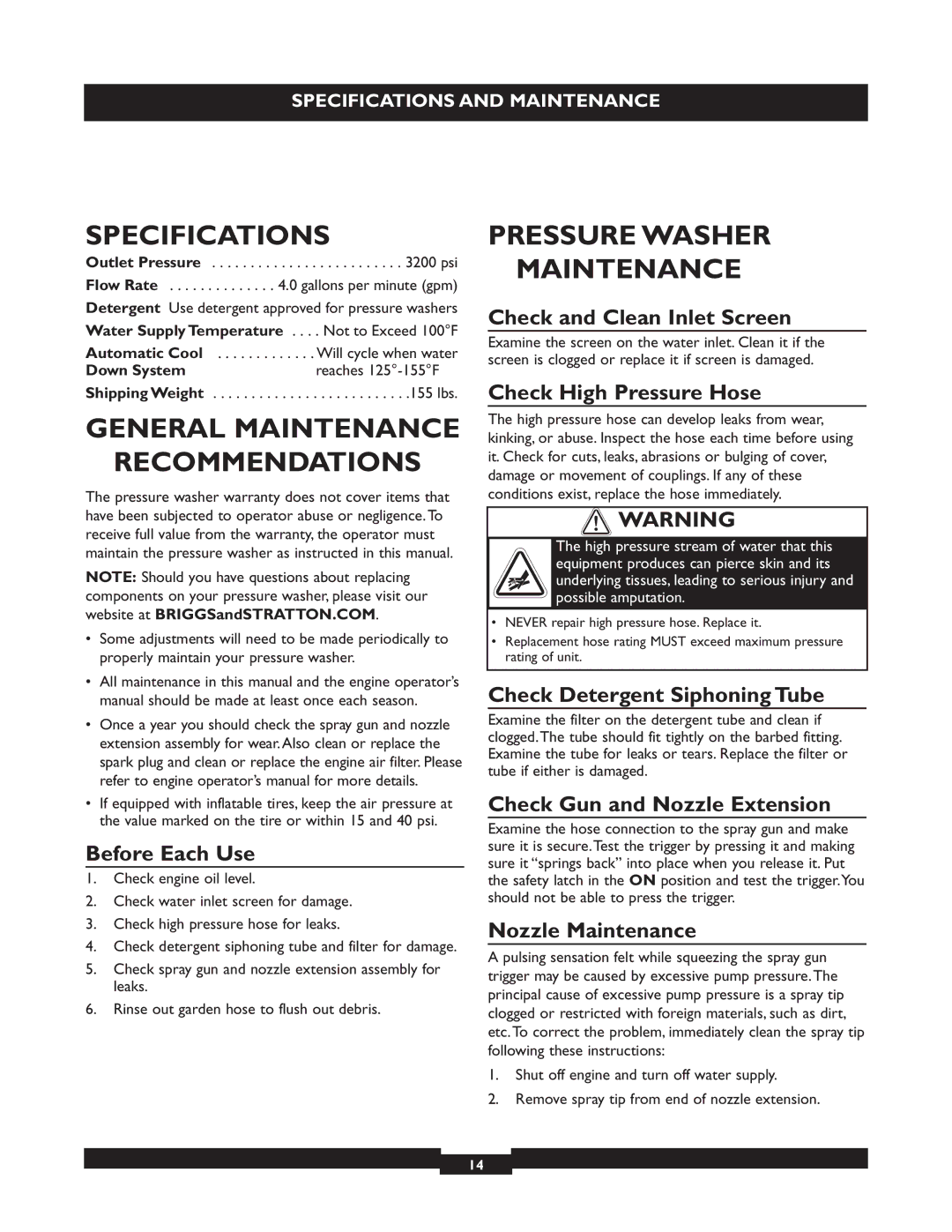
SPECIFICATIONS AND MAINTENANCE
SPECIFICATIONS
Outlet Pressure . . . . . . . . . . . . . . . . . . . . . . . . . 3200 psi Flow Rate . . . . . . . . . . . . . . 4.0 gallons per minute (gpm) Detergent Use detergent approved for pressure washers Water Supply Temperature . . . . Not to Exceed 100°F
Automatic Cool . . . . . . . . . . . . . Will cycle when water
Down Systemreaches
GENERAL MAINTENANCE RECOMMENDATIONS
The pressure washer warranty does not cover items that have been subjected to operator abuse or negligence.To receive full value from the warranty, the operator must maintain the pressure washer as instructed in this manual.
NOTE: Should you have questions about replacing components on your pressure washer, please visit our website at BRIGGSandSTRATTON.COM.
•Some adjustments will need to be made periodically to properly maintain your pressure washer.
•All maintenance in this manual and the engine operator’s manual should be made at least once each season.
•Once a year you should check the spray gun and nozzle extension assembly for wear.Also clean or replace the spark plug and clean or replace the engine air filter. Please refer to engine operator’s manual for more details.
•If equipped with inflatable tires, keep the air pressure at the value marked on the tire or within 15 and 40 psi.
Before Each Use
1.Check engine oil level.
2.Check water inlet screen for damage.
3.Check high pressure hose for leaks.
4.Check detergent siphoning tube and filter for damage.
5.Check spray gun and nozzle extension assembly for leaks.
6.Rinse out garden hose to flush out debris.
PRESSURE WASHER
MAINTENANCE
Check and Clean Inlet Screen
Examine the screen on the water inlet. Clean it if the screen is clogged or replace it if screen is damaged.
Check High Pressure Hose
The high pressure hose can develop leaks from wear, kinking, or abuse. Inspect the hose each time before using it. Check for cuts, leaks, abrasions or bulging of cover, damage or movement of couplings. If any of these conditions exist, replace the hose immediately.
![]() WARNING
WARNING
The high pressure stream of water that this equipment produces can pierce skin and its underlying tissues, leading to serious injury and possible amputation.
•NEVER repair high pressure hose. Replace it.
•Replacement hose rating MUST exceed maximum pressure rating of unit.
Check Detergent Siphoning Tube
Examine the filter on the detergent tube and clean if clogged.The tube should fit tightly on the barbed fitting. Examine the tube for leaks or tears. Replace the filter or tube if either is damaged.
Check Gun and Nozzle Extension
Examine the hose connection to the spray gun and make sure it is secure.Test the trigger by pressing it and making sure it “springs back” into place when you release it. Put the safety latch in the ON position and test the trigger.You should not be able to press the trigger.
Nozzle Maintenance
A pulsing sensation felt while squeezing the spray gun trigger may be caused by excessive pump pressure.The principal cause of excessive pump pressure is a spray tip clogged or restricted with foreign materials, such as dirt, etc.To correct the problem, immediately clean the spray tip following these instructions:
1.Shut off engine and turn off water supply.
2.Remove spray tip from end of nozzle extension.
14
